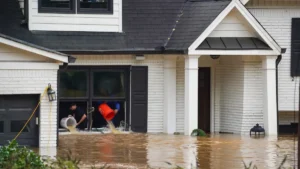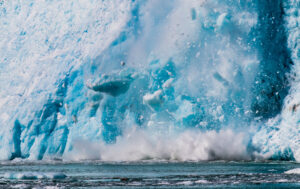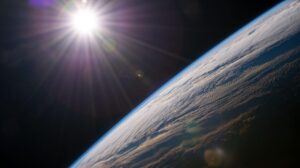Climate Change Threatens the Pacific With Seesaw Sea Levels
Coasts and communities in the Pacific region will face more extreme weather hazards as a changing climate magnifies the El Niño effect, scientists say.
By Tim Radford, Climate News Network

Severe coastal erosion at San Francisco’s Ocean Beach as a result of storm damage during the 2009-10 El Niño. (Jeff Hansen / US Geological Survey)
This Creative Commons-licensed piece first appeared at Climate News Network.
LONDON — El Niño, that periodic bubble of heat that hits the tropical Pacific every few years, has nothing to do with climate change — but the phenomenon could be made much more devastating by climate change, according to two new studies.
And that is bad news for a region where vulnerable coastlines are already at risk from serious storms, floods and rising sea levels.
One set of researchers reports in Science Advances that, in response to El Niño, Western Pacific sea levels will fall and rise more frequently by 2100. When they fall, they threaten the corals with a foul-smelling tide; when they rise, they threaten to flood the atolls.
And another group reports in Nature Geoscience that the alternating impact of a blistering El Niño and its chillier sister, La Niña, could bring more extreme flooding and more damaging erosion to the entire Pacific region.
Scientists have already warned once this year that a periodic cycle of warming and cooling in the Pacific could increase in frequency.
Bubble of heat
El Niño is a cyclic phenomenon that tends to manifest itself at Christmas time, which is why, long ago, Peruvian fishermen started giving it the name that means “The Child” in Spanish.
A great bubble of ocean heat moves eastward across the Pacific, causing sea levels in one place to rise, in another to fall, bringing floods and storms to the normally dry west coasts of the Americas, and bringing drought and even forest fires to the rainforests of Indonesia.
A notorious El Niño in 1998 helped make that year one of the hottest ever recorded, and since then meteorologists and climate scientists have been puzzling about what will happen to this natural cycle as carbon dioxide levels rise — in response to human combustion of fossil fuels — and in turn raise average global temperatures.
Matthew Widlansky, a climate researcher at the International Pacific Research Centre in Hawai’i, and colleagues report in that global warming will enhance El Niño-linked sea-level extremes.
This, in turn, will mean very low sea levels in the western Pacific, followed six months later by a seesaw in north-south sea levels, in which the seas drop by as much as 30 centimetres, to expose vulnerable coral ecosystems. And these could double in frequency.
“Utilising many years of data enabled us to definitively identify how the major climate drivers affect coastal hazards across the Pacific.”
“The possibility of more frequent flooding in some areas and sea level drops in others would have severe consequences for the vulnerable coastlines of Pacific islands,” Dr Widlansky says.
Patrick Barnard, a coastal geologist at the US Geological Survey in Santa Cruz, California, and colleagues report that they took a different line of approach to arrive at a similar conclusion.
Thirteen research institutions looked at data from 48 Pacific beaches in the US, Canada, Japan, Australia, New Zealand and Hawai’i from 1979 to 2012 to see if patterns in coastal change could be linked to climate cycles such as El Niño and La Niña. They too found that climate change was likely to make such events worse.
“Shoreline behaviour can be controlled by so many different factors, both locally and regionally, that it’s been difficult to isolate the signal until now,” Dr Barnard says.
Predict impacts
“However, utilising the many years of data we were able pull together in this study enabled us to definitively identify how the major climate drivers affect coastal hazards across the Pacific. This will greatly enhance our ability to predict the broader impacts of climate change at the coast.”
C o-author Mitchell Harley, a civil and environmental engineer at the University of New South Wales, Australia, says: “Coastlines of the Pacific are particularly dynamic as they are exposed to storm waves generated often thousands of miles away.
“This research is of particular importance as it can help Pacific coastal communities prepare for the effects of changing storm regimes driven by climate oscillations like El Niño and La Niña.
“To help us complete the puzzle, for the next step we would like to look at regions of the Pacific like South America and the Pacific Islands, where very limited shoreline data currently exists.”
Your support is crucial…With an uncertain future and a new administration casting doubt on press freedoms, the danger is clear: The truth is at risk.
Now is the time to give. Your tax-deductible support allows us to dig deeper, delivering fearless investigative reporting and analysis that exposes what’s really happening — without compromise.
Stand with our courageous journalists. Donate today to protect a free press, uphold democracy and unearth untold stories.









You need to be a supporter to comment.
There are currently no responses to this article.
Be the first to respond.